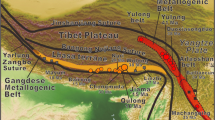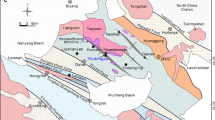Abstract
Gossan Hill is an Archean (∼3.0 Ga) Cu–Zn–magnetite-rich volcanic-hosted massive sulfide (VHMS) deposit in the Yilgarn Craton of Western Australia. Massive sulfide and magnetite occur within a layered succession of tuffaceous, felsic volcaniclastic rocks of the Golden Grove Formation. The Gossan Hill deposit consists of two stratigraphically separate ore zones that are stratabound and interconnected by sulfide veins. Thickly developed massive sulfide and stockwork zones in the north of the deposit are interpreted to represent a feeder zone. The deposit is broadly zoned from a Cu–Fe-rich lower ore zone, upwards through Cu–Zn to Zn–Ag–Au–Pb enrichment in the upper ore zone. New sulfur isotope studies at the Gossan Hill deposit indicate that the variation is wider than previously reported, with sulfide δ34S values varying between −1.6 and 7.8‰ with an average of 2.1 ± 1.4‰ (1σ error). Sulfur isotope values have a broad systematic stratigraphic increase of approximately 1.2‰ from the base to the top of the deposit. This variation in sulfur isotope values is significant in view of typical narrow ranges for Archean VHMS deposits. Copper-rich sulfides in the lower ore zone have a narrower range (δ34S values of −1.6 to 3.4‰, average ∼1.6 ± 0.9‰) than sulfides in the upper ore zone. The lower ore zone is interpreted to have formed from a relatively uniform reduced sulfur source dominated by leached igneous rock sulfur and minor magmatic sulfur. Towards the upper Zn-rich ore zone, an overall increase in δ34S values is accompanied by a wider range of δ34S values, with the greatest variation occurring in massive pyrite at the southern margin of the upper ore zone (−1.0 to 7.8‰). The higher average δ34S values (2.8 ± 2.1‰) and their wider range are explained by mixing of hydrothermal fluids containing leached igneous rock sulfur with Archean seawater (δ34S values of 2 to 3‰) near the paleoseafloor. The widest range of δ34S values at the southern margin of the deposit occurs away from the feeder zone and is attributed to greater seawater mixing away from the central upflow zone.
Similar content being viewed by others
Author information
Authors and Affiliations
Additional information
Received: 10 June 1999 / Accepted: 28 December 1999
Rights and permissions
About this article
Cite this article
Sharpe, R., Gemmell, J. Sulfur isotope characteristics of the Archean Cu–Zn Gossan Hill VHMS deposit, Western Australia. Mineral. Deposita 35, 533–550 (2000). https://doi.org/10.1007/s001260050260
Issue Date:
DOI: https://doi.org/10.1007/s001260050260




